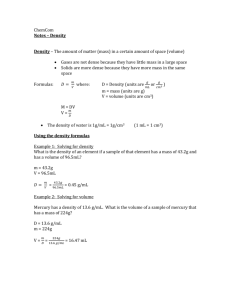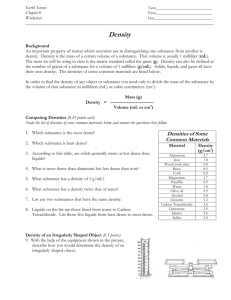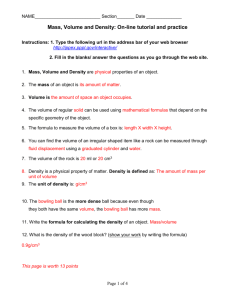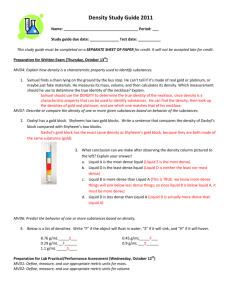What`s My Density?
advertisement
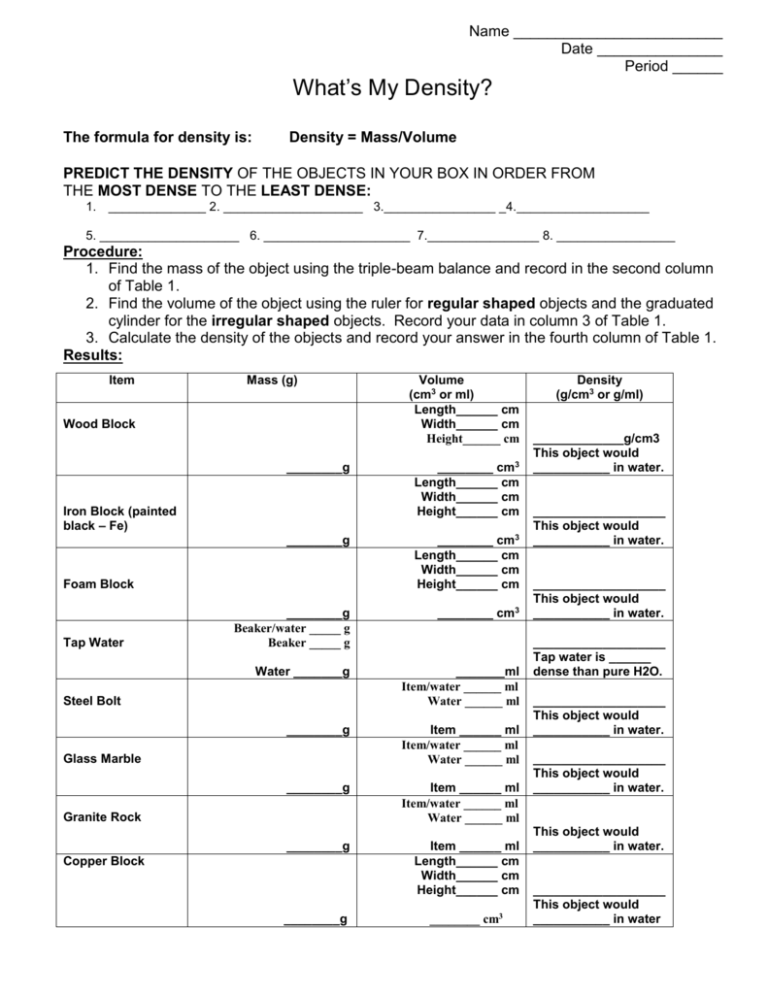
Name _________________________ Date _______________ Period ______ What’s My Density? The formula for density is: Density = Mass/Volume PREDICT THE DENSITY OF THE OBJECTS IN YOUR BOX IN ORDER FROM THE MOST DENSE TO THE LEAST DENSE: 1. ______________ 2. ____________________ 3.________________ _4.___________________ 5. ____________________ 6. _____________________ 7.________________ 8. _________________ Procedure: 1. Find the mass of the object using the triple-beam balance and record in the second column of Table 1. 2. Find the volume of the object using the ruler for regular shaped objects and the graduated cylinder for the irregular shaped objects. Record your data in column 3 of Table 1. 3. Calculate the density of the objects and record your answer in the fourth column of Table 1. Results: Item Mass (g) Wood Block ________g Iron Block (painted black – Fe) ________g Foam Block Tap Water Volume (cm3 or ml) Length______ cm Width______ cm Height______ cm ________ cm3 Length______ cm Width______ cm Height______ cm ________ cm3 Length______ cm Width______ cm Height______ cm ________g Beaker/water _____ g Beaker _____ g ________ cm3 Water _______g _______ml Item/water ______ ml Water ______ ml Steel Bolt ________g Glass Marble Item ______ ml Item/water ______ ml Water ______ ml ________g Item ______ ml Item/water ______ ml Water ______ ml ________g Item ______ ml Length______ cm Width______ cm Height______ cm Granite Rock Copper Block ________g ________ cm3 Density (g/cm3 or g/ml) _____________g/cm3 This object would ___________ in water. ___________________ This object would ___________ in water. ___________________ This object would ___________ in water. ___________________ Tap water is ______ dense than pure H2O. ___________________ This object would ___________ in water. ___________________ This object would ___________ in water. This object would ___________ in water. ___________________ This object would ___________ in water Graph: Plot your data on a weight vs. mass graph. Title the graph “What’s My Density?” Label the x-axis “Volume in milliliters” and the y-axis “Mass in grams.” Draw a line from each point to the origin. Label each point with the name of the object or color coordinate each line and provide a key. Questions: (Do not answer questions until you have had your graph graded by teacher) 1. What does the slope of the line of a mass vs. volume graph show? 2. How do you know just by looking at the graph which object was the most dense? Least dense? 3. What is the density of pure water? How can you tell by looking at the graph which items will float in water? 4. Describe how you found the volume of an irregular shaped object. 5. If you have two identical boxes and one is filled with 1000g of feathers and the other box is fill with 100g of rocks. a. Which box weighs the most? _____________________________ b. Which box contains more items?____________________________ c. Which box is the most dense? ____________________________ 6. If you had a larger marble (10 ml) made of the exact same material what would its mass be? Would its density change?(use graph to answer and show your work) 7. Density is a ratio that shows the relationship between mass and volume. Make a statement that describes how you know if an object will float or sink based on the mass of the object compared to the volume of the object. EXTRA CREDIT (OPTIONAL) 1. If a Styrofoam cube had a mass of 100 grams would it be more dense than a marble? What would the volume of Styrofoam cube be if its mass was 100g? (use the density formula to answer –show your work)
